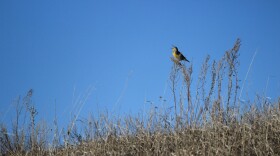Shortly after beginning their journey down the Missouri River in April of 1805 after spending the winter at Fort Mandan, Meriwether Lewis wrote in his journal about an animal that Captain Clark had recently observed: “Captain Clark walked on shore today and informed on his return, that passing through the prairie he had seen an animal that precisely resembled the burrowing squirrel, accept in point of size, it being only about one third as large as the squirrel, and that it also burrows.”
Clark, as you might surmise, saw what we now know at a Richardson’s ground squirrel and the burrowing squirrel Clark referenced was, of course, a prairie dog. Clark is pretty accurate in describing the Richardson’s ground squirrel as about a third the size of a prairie dog. A quick check of Robert Seabloom’s The Mammals of North Dakota shows the prairie dog averages around two pounds while the Richardson’s ground squirrel averages about a half a pound, with the males being a bit larger.
The two species also differ in social habits as well as other aspects of their biology and ecology. Plus, their ranges are quite different in the state. Distribution maps in Seabloom’s book show Richardson’s ground squirrels in all counties north and east of the Missouri River plus McKenzie County. Contrast that with the range of the black-tailed prairie dog which consists of all counties south and west of the Missouri River with the exception of Mercer and Oliver counties. There is also an introduced colony in White Horse Hill National Game Preserve (formerly Sully’s Hill National Game Preserve) in Benson County.
Richardson’s ground squirrels are largely herbivorous, feeding mostly on leaves, seeds, and other plant parts. And although they are sometimes viewed as a varmint (a troublesome wild animal) they are an important species in the ecology of grassland communities. Like many other small mammals, they are an important prey species for a wide variety of predators including hawks, eagles, owls, coyotes, foxes, badgers, weasels, and even some snakes, to name a few.
—
Further Reading
- Seabloom, Robert. 2020. The Mammals of North Dakota. North Dakota State University Press, Fargo, ND. Second Edition. 470 pages.





